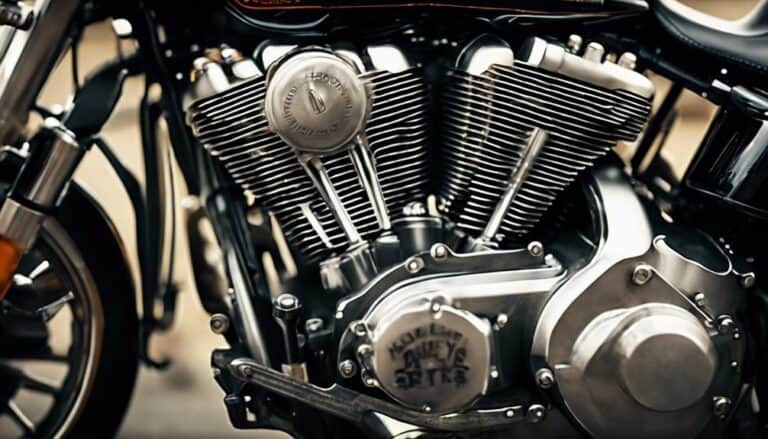When you think of the 1982 Harley Davidson, you're probably wondering what motors powered those iconic bikes. Well, let's shed some light on this topic.
The engines that graced the 1982 models were a mix of power, performance, and legacy. From the raw strength of the Shovelhead Engine to the refined efficiency of the Evolution Engine, each motor had its own story to tell.
So, which engine ultimately roared to life in the heart of these classic motorcycles? Find out as we uncover the secrets behind the motors that drove the 1982 Harley Davidson into the annals of motorcycle history.
Key Takeaways
- The 1982 Harley-Davidson model featured the Shovelhead engine generation.
- The Shovelhead engine came in 74ci (1212cc) and 80ci (1340cc) variants.
- Shovelhead engines were known for improved performance over the earlier Panhead models.
- The Shovelhead engine marked a transition before the Evolution Engine was introduced in 1984.
Evolution Engine Overview
The Evolution Engine, introduced by Harley-Davidson in 1984, revolutionized their Softail models with enhanced fuel efficiency and torque. This 1340cc engine, with its all-aluminum construction, not only provided a power boost but also a more reliable and durable performance. Considered the forefather of the Softail series, this engine marked a new era for Harley-Davidson, setting the stage for future innovations. Its design allowed for a cooler running temperature, contributing to a smoother ride compared to previous models.
This engine's impact went beyond just performance upgrades; it played a vital role in revitalizing Harley-Davidson's lineup during a crucial period. Riders seeking liberation on the open road found the Evolution Engine to be a game-changer, delivering up to 65 hp and a significant improvement in overall riding experience. Harley-Davidson's success during that era can be attributed in part to the innovation and reliability that the Evolution Engine brought to their motorcycles.
Shovelhead Engine Specs
Characterized by their unique shovel-like rocker box covers, the Shovelhead engines produced by Harley-Davidson from 1966 to 1984 offered riders enhanced power and performance. These engines were available in two variants: the 74ci (1212cc) and the 80ci (1340cc), providing increased displacement for a more robust riding experience. The Shovelhead engine design drew inspiration from the earlier Knucklehead engines, featuring a distinct appearance that set them apart in Harley-Davidson's lineup. Notably, these engines marked an improvement in performance compared to the preceding Panhead models, showcasing Harley-Davidson's commitment to evolving their technology.
| Specification | Description |
|---|---|
| Engine Type | V-Twin |
| Displacement | 74ci (1212cc) / 80ci (1340cc) |
| Production Years | 1966 – 1984 |
| Notable Feature | Shovel-like rocker box covers |
The Shovelhead engines not only represented a shift in Harley-Davidson's engine technology but also a nod to the brand's heritage through their distinctive design elements. Riders found in the Shovelhead a blend of power, performance, and a classic aesthetic that continues to captivate enthusiasts to this day.
Panhead Engine Features
Drawing on its distinctive aluminum heads and hydraulic valve lifters, the Panhead engine from Harley-Davidson, produced from 1948 to 1965, exemplified a blend of durability and innovative design.
The Panhead engine, available in 61ci and 74ci variants, boasted a displacement range of 983cc to 1212cc, offering riders a choice based on their preferences.
The name 'Panhead' was coined due to the pan-shaped rocker covers adorning the engine, adding a touch of uniqueness to its appearance.
Renowned for its durability and strength, the Panhead engine marked a significant milestone in Harley-Davidson's engine history, setting new standards for performance and reliability.
Riders seeking a balance between power and endurance found the Panhead engine to be a reliable companion on long rides, making it a beloved choice among motorcycle enthusiasts.
Knucklehead Engine Details
Featuring groundbreaking overhead valves, Knucklehead engines, manufactured by Harley-Davidson between 1936 and 1947, ushered in a new era of power and performance in motorcycle engineering. These engines were a significant advancement for Harley-Davidson, offering power outputs of up to 48 horsepower. Available in 61 cubic inch (1000cc) and 74 cubic inch (1200cc) configurations, Knucklehead engines were known for their distinctive rocker boxes that resembled human fists, giving them a unique and memorable appearance.
To provide a clearer overview, let's look at the specifications of Knucklehead engines in a table:
| Specification | Details |
|---|---|
| Cubic Inch | 61 (1000cc) and 74 (1200cc) |
| Rocker Boxes | Distinctive human fist design |
| Power Output | Up to 48 horsepower |
These details highlight the innovative design and capabilities of the Knucklehead engines, cementing their place in motorcycle history as a symbol of Harley-Davidson's commitment to performance and engineering excellence.
Flathead Motor Specifications
Harley-Davidson's Flathead engine, produced from 1929 to 1973, distinguished itself with its flat and curved cylinder heads, setting the stage for a legacy of durability and performance in motorcycle engineering.
The Flathead engine featured a sideways valve arrangement and came in various sizes ranging from 45ci to 80ci, making it adaptable for different models and riding preferences. Known for its simplicity and reliability, this engine was optimized for up to 1340ccm³ and 34 horsepower, showcasing a balance between power and efficiency.
As a significant part of Harley-Davidson's historical engine lineup, the Flathead engine symbolized durability and performance, proving its longevity on the road and in the hearts of motorcycle enthusiasts. This iconic engine design not only provided power but also became a cornerstone for future innovations in motorcycle technology.
Conclusion
As you reflect on the engines that powered the 1982 Harley Davidson models, remember that each one symbolizes a chapter in the rich history of motorcycle engineering.
The Evolution Engine represents progress and innovation, the Shovelhead embodies power and reliability, the Panhead exudes classic style, the Knucklehead signifies craftsmanship and tradition, and the Flathead showcases simplicity and endurance.
These engines are more than just components – they're the beating heart of a legendary era in motorcycle history.

